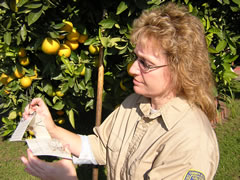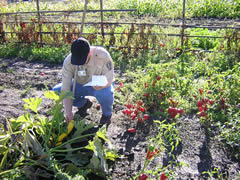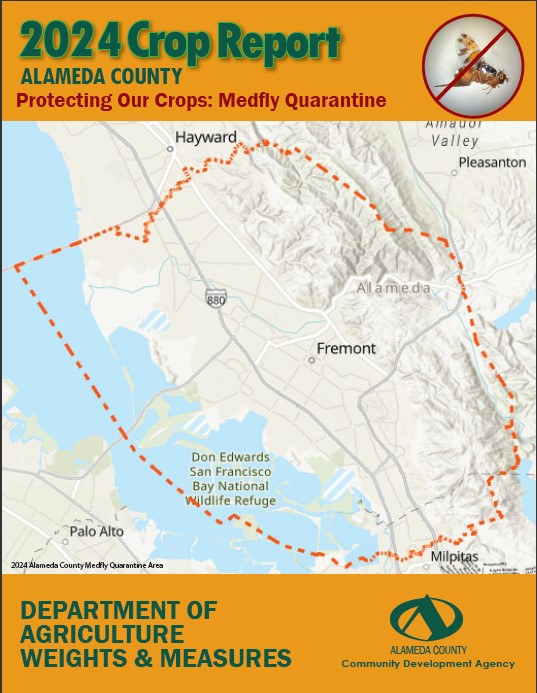Pest Detection
Melon Fruit Fly

Inspecting the contents
on the sticky insert.*

Inspecting traps in a home garden for the
presence of Melon fruit fly.*
Common Name: Melon Fly
Scientific Name:Bactrocera cucurbitae (Coquillett)
Pest Rating: "A"
DESCRIPTION
Adult Melon fruit flies are similar in size to a housefly, about 6mm to 8 mm long. The body is light brown to a honey color in appearance. There are several prominent bright yellow markings on the thorax (upper body) and a distinctive black 'T' pattern at the base of the abdomen (lower body). The wings are clear with a dark coastal vein and "melon seed" shaped spot at the tip. Females have a slender pointed ovipositor which they use to lay eggs under the skin of the host fruit. Larvae (maggots) are white and legless, growing to a length of 10mm inside the host fruit.
HISTORY AND ECONOMIC IMPORTANCE
Melon flies were first introduced to the United States via Hawaii in 1895. They have since become a major agricultural pest particularly of cantaloupes, cucumbers, and watermelons. Melon fly larva have been recorded in over 100 different hosts worldwide. Many California crops would be threatened by the introduction of this pest including peaches, oranges, beans, tomatoes, and most plants in the cucumber family. Damage to so many of our important crops would raise our produce prices.
Frequently traps are hung in fruiting trees with a garden nearby.
Alameda county's Melon fly trapping season is from May through October.
If you have a vegetable garden or fruit tree where a melon fly trap could be placed and monitored during the fruiting season we would love to hear from you!
DISTRIBUTION
The Melon fly is native to Asia. They can be also be found in Africa, Sri Lanka, China, Guam, India, New Guinea, Taiwan, Rota, the Ryukyu Islands, Thailand, and much of Southeast Asia. In the United States, its distribution is limited to the Hawaiian Islands.
ALAMEDA COUNTY PEST DETECTION
To date there have been no Melon flies discovered in traps in Alameda County. However we are at significant risk from this pest due to a high number of potential hosts, being in an agriculture rich state, having a diverse community, and the presence of a major port.
Early detection is the key.
Hundreds of Melon fruit fly traps are distributed throughout the county. These cardboard "Jackson" traps contain a pheromone to lure male flies where they become trapped on a sticky board insert. All melon fly traps are checked every 2 weeks by agriculture inspectors to assure our county is free from this destructive pest.
HOSTS AND DAMAMGE
Fruit that has been attacked may be unfit to eat. Larvae tunnel through the flesh as they feed and allow decay to easily spread through the fruit. This often leaves the interior of the fruit rotten. Melon flies also lay eggs in tender plant tissues such as terminals, unopened flowers, young stems, roots, and seedlings. This may result in the death of the plant. Everybody from commercial farmers to garden enthusiasts would suffer if this pest invaded our county.
YOU CAN HELP
Working together we can keep these pests from becoming established in Alameda County. You can help by allowing Agriculture employees access to your property to install and monitor insect survey traps. To learn more, select the link below:
Pest Detection Survey

 Community Development Agency
Community Development Agency AGRICULTURE PROGRAMS
AGRICULTURE PROGRAMS

